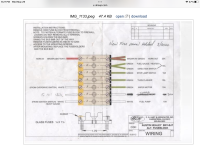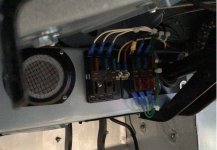Well here goes. I've read Daniel's work and here is my take away from that article.
- I agree that voltage drop can be a problem.
- I don't agree that the original wiring, i.e. wire size is inadequate.
- I can't accept that saying that the headlight circuit was inadequate when new irregardless of it's time in use.
- I say that you can guard against unwanted voltage drop by maintaining good electrical connections.
- Even if you are running an original generator the voltage regulator is designed to maintain the minimum voltage required for the systems and components in the car.
- If you are experiencing voltage problems then you should rebuild or replace existing components in the car such as the generator and voltage regulator as well as maintaining clean quality connections.
- If you have an alternator in your car you will experience less voltage problems than with a generator. But if you do have problems then some component is failing.
- If you "add" electrical "load" (something that draws more current) such as radio/sterio/GPS/Fog lamps/stronger high capacity fuel pump, etc) you can overload your electrical supply (generator/alternator/battery) which will cause a voltage drop and problelms.
- If you change out lights to LED the the LED bulbs draw less current than the original incandescent bulbs did and will have no problem running on original wiring. REMINDER, all original connections should be maintained in good condition.
- I have Halogen headlight bulbs in my Healey. They have been operating on the original design wiring (replaced complete harness when I restored the car 20 years ago) for 20+ years. They were in the car when I bought it so they were obviously running on the original harness.
- Daniel's theorizations about percentage loss of voltage and subsequent light levels is in my opinion irrelevant subterfuge. Your voltage and lights levels he describes should never reach those levels unless you are limping home with a damaged vehicle.
- Daniels's description under the heading "How to Solve Voltage Drop" is really a foray into describing the value of relays. The only problem with his premise is that it isn't necessary. The answer to how to solve voltage drop is to maintain the existing components and connections in any car. I'm sure any mechanic of any era car will tell you that.
____________________________________________________________________________
The only reason to ever add a relay is if you are adding a component that draws really high current. An example being many electric engine cooling fans. Also remember when adding a new high draw component you must consider the supply source built into your car. An inadequate generator or alternator or battery will still be inadequate whether a relay or not.
I have to conclude with Jack's concern for reliability. An original Healey has 3 components in its lighting circuit that might fail. The headlights themselves, the dimmer switch and the headlight switch. In the case of adding relays you now have 5. The headlights, the dimmer, the main headlight switch and the 2 relays. You can improve your headlight circuit reliability by 40% if you remove the relays.

 Hi Guest!
Hi Guest!

 smilie in place of the real @
smilie in place of the real @
 Pretty Please - add it to our Events forum(s) and add to the calendar! >>
Pretty Please - add it to our Events forum(s) and add to the calendar! >> 


